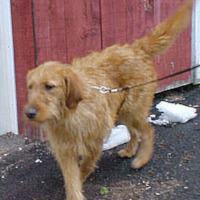Appearance of the Goldendale
|
| The Goldendale is a large dog with long, muscular limbs. They are well proportioned and should not have exaggerated features. Their skull is of medium size, and their muzzle is long and square, ending in a large black varnished nose. Their neck is strong and sturdy but not too broad, and their body is rectangular. Their tail is carried straight and may or may not be feathered. Weighing between 22 and 34 kg and measuring between 53 and 58 cm, the Goldendale tends to weigh more than the Airedale but is often a little shorter. The Goldendale's coat can be as long and wavy as the Golden Retriever's, but is generally shorter and stiffer. It's a double layer that offers protection in cold weather and allows faster drying time after swimming. Potential coat colors include golden, fawn, brown, black and beige. |
Temperament of the Goldendale
|
| The Goldendale should have a gentle attitude and be tolerant in most situations, but they also possess the Terrier spirit and can therefore be more boisterous than an owner expects. They can be quite independent and need a firm hand and a very patient owner to keep them level-headed. Born to hunt, Goldendales retain their hunting instinct and love to scent and stalk. For this reason, they cannot be housed alongside pets such as rabbits. They can, however, get along with other dogs and generally enjoy their company. A dog that needs a lot of mental and physical stimulation, failing which will result in a chronically unhappy dog who will act out by becoming destructive and misbehaving. Tail-running, digging and chewing are all common behavioral vices in a bored Goldendale. |
Needs and activities of the Goldendale
|
| The Goldendale is described as an active hybrid. He likes to be busy, so you'll need to work both his mind and body so you can relax a little at the end of the day. A minimum of two or three walks a day will suit this curious breed best. Try him out as a jogging partner and on the trail, visit the dog park so he can exercise his social skills. Keep him on a leash, however, as he may go chasing if he gets the chance. This hybrid is too energetic for an apartment. A home where he can stretch out and have access to fresh air in a secure, fenced-in area throughout the day is ideal. |
Maintenance of the Goldendale
|
| The Goldendale has a fairly low maintenance routine. As with all dogs, dental care should be a priority. You want to avoid sore gums and unnecessary dental surgery or extractions, so make sure you clean your hybrid's teeth several times a week. Trim his nails when necessary; this will be once or twice a month, depending on how quickly he wears them down naturally. As for coat care, the need for brushing or trimming will depend on parental influences. A dense, stiff coat will be kept tidy with weekly brushing with the smooth brush and perhaps a quick combing twice a week. A thick, wavy coat with fringing on chest, back of thighs and tail may need daily brushing with the brush to prevent matting. |









 English (United Kingdom)
English (United Kingdom)